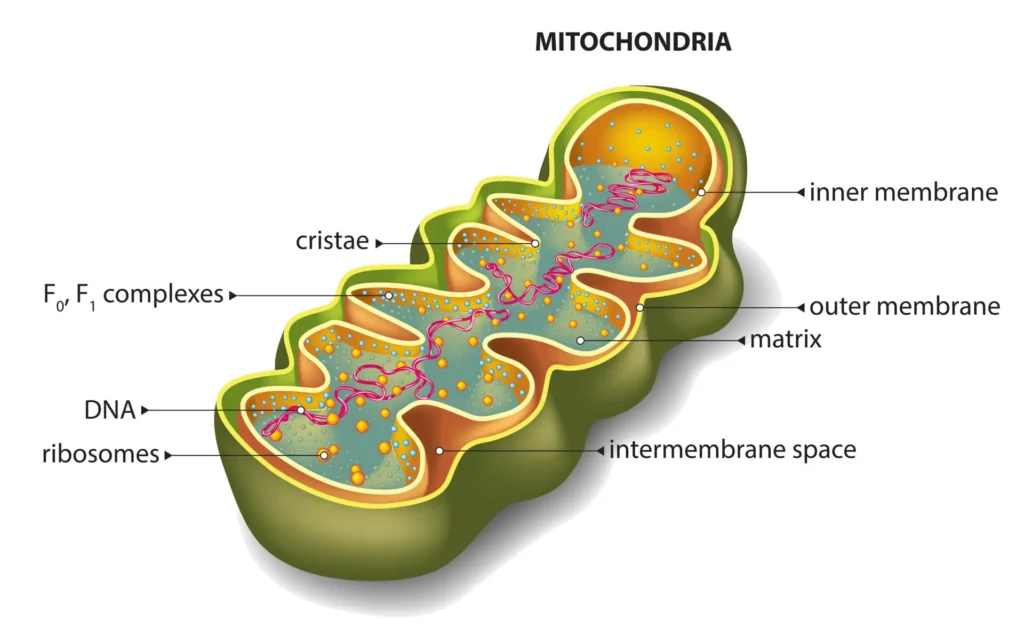Mitochondria: The Powerhouse of the Cell
Mitochondria are often referred to as the “powerhouses” of the cell, and with good reason. These tiny organelles play a critical role in generating energy that cells need to function, driving everything from movement to metabolism. But mitochondria are much more than just cellular power generators—they are key players in maintaining cellular health and have a fascinating history that goes back over a billion years.
What Are Mitochondria?
Mitochondria, membrane-bound organelles, exist in most eukaryotic cells, including plants, animals, and fungi. Each cell contains hundreds or thousands of mitochondria based on its energy needs. For example, muscle cells, which require more energy to function, contain more mitochondria than other cells.
Structure of Mitochondria
Mitochondria have a double membrane structure:
- Outer membrane: This smooth membrane encloses the entire organelle and acts as a protective barrier. It contains proteins that allow molecules to pass in and out.
- Inner membrane: This membrane is folded into structures called cristae, which increase its surface area. The inner membrane is where the key steps of energy production occur.
- Matrix: The space inside the inner membrane is called the matrix, where mitochondrial DNA, ribosomes, and various enzymes involved in energy production are located.
Mitochondria contain their own DNA, separate from the DNA in the cell’s nucleus. Furthermore, cells inherit this DNA maternally, likely a remnant of an ancient symbiotic relationship between a primitive eukaryotic cell and a bacteria-like organism.
The Role of Mitochondria in Energy Production
The primary function of mitochondria is to produce energy through a process called cellular respiration. This process converts nutrients like glucose into adenosine triphosphate (ATP), the cell’s main energy currency. Without ATP, cells wouldn’t be able to perform essential tasks like synthesizing molecules, transporting substances, or even dividing.
Steps of Cellular Respiration:
- In Glycolysis, which occurs in the cytoplasm, the process breaks down glucose into two molecules of pyruvate, generating a small amount of ATP and high-energy NADH molecules.
- In the Krebs Cycle (Citric Acid Cycle) in the mitochondrial matrix, pyruvate enters the mitochondria and breaks down further, producing more NADH and FADH2, which both carry high-energy electrons.
- In the Electron Transport Chain (ETC) in the inner membrane, NADH and FADH2 deliver high-energy electrons to the ETC, which passes them along a series of proteins. The transfer releases energy, which pumps protons across the inner membrane, creating a gradient.
- ATP Synthesis: The protons flow back into the matrix through a protein called ATP synthase, which uses the energy from this flow to convert ADP (adenosine diphosphate) into ATP.
At the end of this process, oxygen (which we breathe) accepts the electrons and combines with protons to form water—a crucial step for preventing the buildup of free radicals that can damage cells.
Beyond Energy: Other Functions of Mitochondria
While energy production is their primary role, mitochondria are involved in several other critical functions:
1. Regulation of Cell Death (Apoptosis)
Mitochondria play a key role in apoptosis, or programmed cell death, which is essential for removing damaged or unnecessary cells. During apoptosis, mitochondria release proteins that activate a cascade of events leading to cell death. This process is vital for tissue development, immune response, and preventing cancer.
2. Calcium Storage
Mitochondria help regulate calcium levels in cells. Calcium is an essential signaling molecule involved in various cellular processes, including muscle contraction, nerve signaling, and hormone release. Additionally, by buffering and storing calcium, mitochondria help maintain cellular health and prevent damage from calcium overload.
3. Heat Production (Thermogenesis)
In brown fat cells, specialized mitochondria can produce heat instead of ATP, a process known as thermogenesis. This process is important for regulating body temperature, especially in newborns and hibernating animals. It is driven by a protein called uncoupling protein 1 (UCP1), which disrupts the normal process of ATP production, releasing energy as heat.
The Evolutionary Origin of Mitochondria
One of the most fascinating aspects of mitochondria is their evolutionary origin. It is widely accepted that mitochondria originated from a symbiotic relationship between an ancestral eukaryotic cell and a bacterium. This theory, known as the endosymbiotic theory, suggests that around 1.5 billion years ago, a primitive eukaryotic cell engulfed a free-living bacterium. Instead of digesting it, the two organisms formed a mutually beneficial relationship: the bacterium provided energy for the host cell, and the host provided protection and nutrients for the bacterium.
Over time, this symbiotic relationship became permanent, and the bacterium evolved into modern mitochondria. Evidence supporting this theory includes the fact that mitochondria have their own circular DNA, similar to bacteria, and they replicate independently of the cell, like bacteria.
Mitochondria and Health
Given their central role in energy production and cellular health, it’s no surprise that researchers associate mitochondrial dysfunction with a range of diseases.
1. Mitochondrial Diseases
Genetic mutations in mitochondrial or nuclear DNA cause mitochondrial diseases, affecting mitochondrial function. These disorders can impact any part of the body but most commonly affect organs and tissues with high energy demands, such as the brain, heart, and muscles. Symptoms vary widely, including muscle weakness, neurological problems, and developmental delays.
2. Aging
There is growing evidence that mitochondrial dysfunction plays a role in the aging process. Over time, however, damage to mitochondrial DNA from reactive oxygen species (byproducts of cellular respiration) can impair the mitochondria’s ability to produce energy, leading to cellular damage and aging.
3. Neurodegenerative Diseases
Mitochondrial dysfunction plays a role in neurodegenerative diseases like Parkinson’s and Alzheimer’s. Consequently, these conditions disrupt the energy supply to neurons, causing cell death and brain damage. Meanwhile, researchers continue to investigate the role of mitochondria in these diseases and develop potential therapies targeting mitochondrial health.
